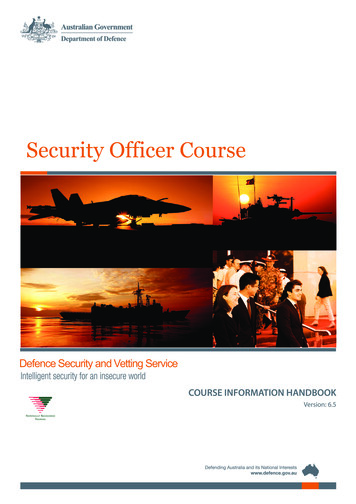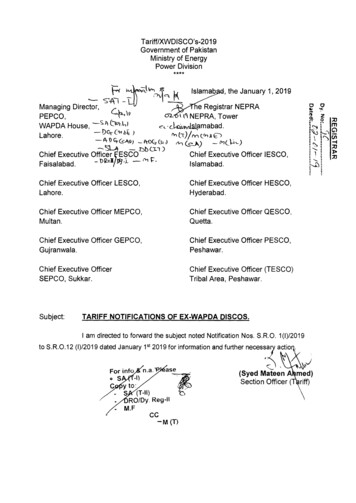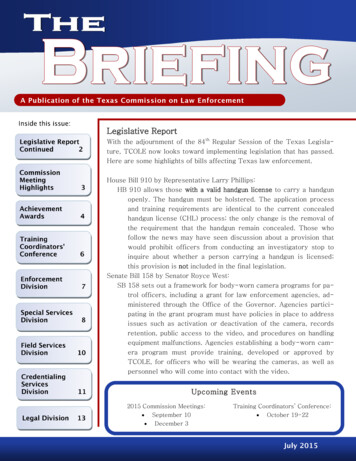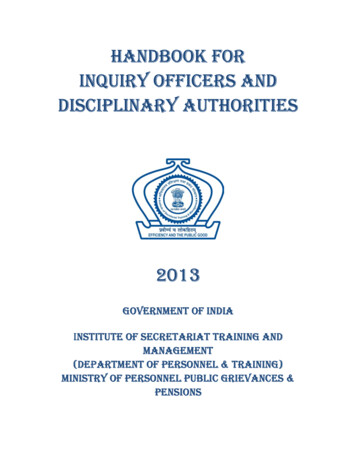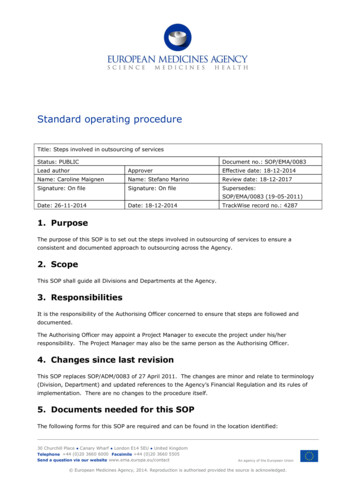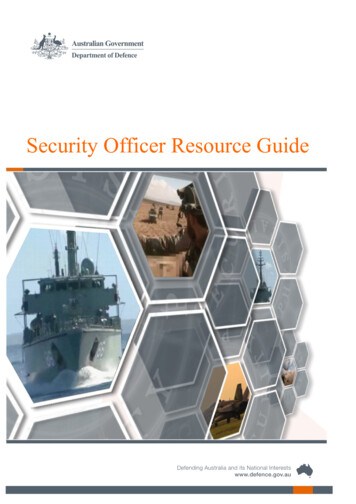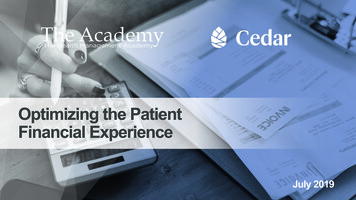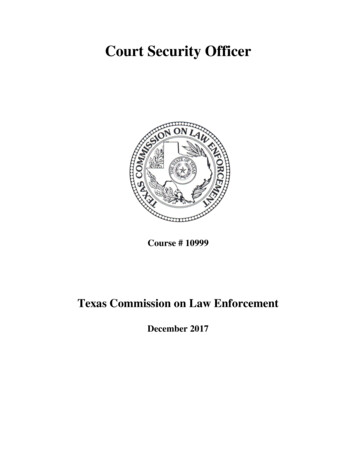
Transcription
Officer Guide
TABLE OF CONTENTSIntroduction to Scholarship in Phi Sigma Kappa . 1Workshop Discussion Guides .Academic Goal Setting . 4Leadership Roles in Phi Sigma Kappa . 9Seven Ways to Improve your Financial Health .15Succeeding in Teams .18Understanding Learning Styles . 22Program Resources .Additional Resources and Conversation Starters . 26CliftonStrengths for Students Information .32Facilitation Best Practices.34Tips on Hosting a Guest Speaker . 37Appendix .CliftonStrengths Themes Quick Reference Card (list of 34 Themes) . 39Sample Programming Calendar .41References .44
INTRODUCTION TO SCHOLARSHIP IN PHI SIGMA KAPPACardinal Journey OverviewCardinal Journey is Phi Sigma Kappa’s comprehensive member development program thatbegins when brothers join the Fraternity and continues throughout their undergraduateexperience.Focused on understanding and utilizing strengths, Scholarship in Phi Sigma Kappa isdesigned for initiated brothers to learn new skills and build upon their natural talents.Participants will become more self-aware and develop stronger skills in the areas ofacademics, leadership, professional/career development, and personal success. Chaptersalso have the opportunity to lead members through the CliftonStrengths assessment somembers can better understand their natural strengths. More information can be foundbelow and in the Clifton Strengths for Students guide.ExpectationsThis program should be facilitated by the Scholarship Chairman, the Vice President oranother appointed officer that best fits the chapter’s officer structure.Chapters can choose to complete the programming expectations either as a group, such asconducting workshops and discussions at chapter meetings, or have members completeindividual tasks on their own time. Individual tasks could include listening to a specificpodcast or visiting the campus career center to have your resume reviewed.Chapters should cover at least one topic per semester, utilizing the list of topics below as aguide.TopicsThe following topics can count towards Scholarship in Phi Sigma Kappa programmingexpectations: Resume and cover letter writingInterview practiceCareer developmentPersonal brand/social media presenceFinancial literacy/money managementAcademic success (study skills, research and writing skills, etc.)Goal settingObtaining leadership roles on campus or within Phi Sigma KappaTeamwork and working with othersObtaining mentors/mentorshipPhysical health, nutrition, wellnessINTRODUCTION: SCHOLARSHIP IN PHI SIGMA KAPPA1
Success in collegeGeneral leadership skills/personal successCliftonStrengths for Students Chapters may also choose to have members complete the CliftonStrengths for Studentsassessment. More information can be found here to obtain assessment codes at a discountthrough International Headquarters (IHQ). This assessment will especially be useful in someof the workshop discussion guides provided by International Headquarters.Resources provided by International HeadquartersIHQ has provided the following discussion guides; each is noted with the topic it coversfrom the list above. Links to the facilitator guide are provided within each title below. Academic Goal Setting (academic success or goal setting)Leadership Roles in Phi Sigma Kappa (leadership roles on campus or in Phi SigmaKappa)Seven Ways to Improve your Financial Health (financial literacy)Succeeding in Teams (teamwork)Understanding Learning Styles (academic success)Tips for success in completing Scholarship in Phi Sigma Kappa1.2.3.4.5.Seek out campus events, speakers, and workshops that are already offered tostudents on your campus and have members attend. Discuss as a brotherhood at your next chapter meeting. You can utilize the discussion questions provided in the Additional Resourcesand Conversation Starters to debrief.Invite someone from your campus to come and speak to your chapter. For example, someone from career services or academic success center couldpresent on a topic within their expertise. They can present their own material or utilize the discussion guides for one ofthe IHQ-provided workshops. See the Tips for Hosting a Guest Speaker resource in your chapter to makethe workshop a success.Ask different brothers or one of your local Chapter Advisers to facilitate theworkshops so it doesn’t fall on one officer. For example, the Treasurer could facilitate the financial literacy/moneymanagement topic, or your Chapter Adviser could facilitate a workshop onpersonal branding since he works in marketing and is in charge of hiring newteam members. If you or another undergraduate officer are facilitating, check out theFacilitation Best Practices resource to prepare yourself to best lead theconversation.Plan ahead—figure out at the beginning of the semester which topic will be coveredhow, and when. See the Sample Programming Calendar resource for how to incorporateCardinal Journey programs and Member Safety Programming expectationswithin your chapter’s calendar.Mix up chapter-level workshops with individual tasks or challenges.INTRODUCTION: SCHOLARSHIP IN PHI SIGMA KAPPA2
For example, cover the physical health and wellness topic by having membersvisit the free nutritionist in your health center and partner with a sorority toconduct a mock interviewing workshop where members of each organizationpractice interviewing each other and give feedback.6. Provide incentives for members to complete expectations. For example, offer points for how many topics members cover on their ownand give a gift card prize at the end of the semester for who has the mostpoints.7. Be sure and work with your IHQ chapter coach and let them know whatprogramming topics you are choosing to focus on. They can also help you come up with ideas to complete programmingexpectations!The three phases of Cardinal Journey:Cardinal Journey was never just for associate members. As a Fraternity, we value lifelonglearning through the continuous pursuit of our three Cardinal Principles. This is why theprogram was designed to reflect our three Cardinal Principles—as this is an expectation forall members: associate, initiated, and alumni. See the chart below to differentiate betweenthe three phases of Cardinal Journey and better understand their purpose, audience, whatmaterials are provided, and the expectation of the chapter to complete Integrate associatemembers into PhiSigma KappaDevelopingacademic, personal,and professionalskillsDevelopinginterpersonal skillsAUDIENCEAssociate membersInitiated membersInitiated membersMATERIALSPROVIDEDMeeting guides andassociate memberworksheetsDiscussion guides,podcastlists/discussionquestions, how touse campusresourcesDiscussion guides,podcastlists/discussionquestions, how touse campusresourcesEXPECTATIONSMinimum of eighttopics coveredbefore initiation,which should occurafter six weeks; sometopics to occur inspecific orderMinimum of twotopics covered eachacademic year atany pointMinimum of twotopics covered eachacademic year atany pointINTRODUCTION: SCHOLARSHIP IN PHI SIGMA KAPPA3
ACADEMIC GOAL-SETTINGPREPARATION: Identify a facilitator: This can be a chapter officer, preferably one with experience infacilitation, or the Scholarship Chairman. Consider asking one of your local ChapterAdvisers or a guest speaker from the learning center, academic success center, ornew student orientation office to facilitate this workshop.This workshop consists of information using Gallup’s CliftonStrengths for Students assessment.o If you have taken the assessment through your campus, you can facilitate theworkshop with members knowing their five Signature Themes.o If you have not taken the assessment, it is not necessary and can be facilitatedwithout it.o If you are interested in members taking the assessment, you should visit yourcareer center, new student orientation office, or academic advising office tosee if they provide codes for students for free. You can also purchase codesusing local chapter funds through the Grand Chapter. Visit theCliftonStrengths for Students Information guide for more information.It could be helpful to have the 34 Themes of Talent handout, provided byCliftonStrengths for Students. This is necessary if your members have not taken theassessment. You can either email it out ahead of time, share the list digitally duringthe workshop, or have printed copies ready to go.You may want to prepare to have a projector to share content on a screen if inperson.TOTAL ESTIMATED TIME: 35 MINUTESWORKSHOP OUTCOMES: Identify or recall individual five Signature Themes of Talent.Apply five Signature Themes to work in classes.Apply talents and Signature Themes to academic goals.INTRODUCTION: 15 minutesShare instructions: Today’s workshop will focus on setting academic goals and using your natural talentsand skills to achieve those goals.First let’s identify a few goals that you want to focus on today.What goals do you have before you graduate, related to your academics?ACADEMIC GOAL SETTING4
o Do you want to achieve Dean’s List honors at least once?o Obtain a work-study job in your academic college or school?o Study abroad or secure an amazing internship?o Or simply pass a really difficult class required for your major?Think of at least two specific goals that you want to accomplish prior to graduation.Feel free to jot them down on scrap piece of paper or in the Notes app in yourphone, so you do not forget. We will revisit them later.Give participants a few minutes to think about their two goals and jot them down.Facilitator note: The below section is written to cater to those who have not taken theCliftonStrengths for Students assessment. If the majority or all your members have takenthe assessment (see above notes in Preparation section of this guide), then you can justhave them use their results of their top five Signature Themes. If not, or if you have a mix ofmembers who have and have not taken the assessment, you can share what’s writtenbelow.Share instructions: Research shows that focusing on building your strengths, as opposed to fixing yourweaknesses, will better help you achieve your goals.Gallup’s CliftonStrengths for Students is an assessment that can help you identify fivenatural talents you are strongest in to help you grow your strengths.They have created a list of 34 Themes of Talent after years of research of humanbehavior.You may have already taken this assessment in high school or college and know yourtop five Signature Themes. If you do, you can recall those five Themes or utilize theprovided list to jog your memory.If you have not taken the assessment, the list of the 34 Themes of Talent from Gallupwill be provided. Review the list and select the five that most resonate with you.Either pass out printed copies of the list of 34 Themes of Talent or have them pull it uponline on their phone. If virtual, you can drop the file in the chat, or share your screen. Havethem take a few minutes to read and select their top five themes.After everyone has selected their top five, ask people to share what they picked and why.Facilitator tip: If you have a large group (20 people); consider having them pair or breakinto small groups to discuss.EVALUATING SIGNATURE THEMES: 10 minutesShare: The first step in utilizing your talents in any setting, especially your academics, iscoming to terms with “where you’re at” with that Theme.You probably don’t use all five talents you’ve identified at all times. You may thinkit’s a talent of yours, but you do not actively think about using it. Wherever you areat, it’s important to work towards leveraging them to the best of your ability.I first want to share a model to help you begin to think about how you can put thesestrengths into practice.The model is called BAAM, and it stands for Believe, Appreciate, Apply and Motivate.ACADEMIC GOAL SETTING5
Facilitator note: It’s best to share this model on a projector screen or share your screen ifpresenting virtually. Believe:o Do you even believe in your strengths? Do you feel as though you havetalents?o What you believe about your talents can affect whether you will even try toachieve your goals.o Your beliefs directly influence your emotions, attitudes, behavior patterns andmotivation.Appreciate:o If you do believe them, what value do you think they bring to your life? Whereand when do you see them play out? How can they benefit you?o One of our primary goals is to increase your understanding of andappreciation for your greatest talents.o This forms the basis for increasing your confidence and for buildingachievement patterns.Apply:o Now that you believe and find value in your talents, let’s build upon them andapply them to daily tasks and interactions to turn them into strengths.o You should provide the initiative for designing your education around yourtalents.o This is likely going to produce superior results, because you won’t be“getting” an education, you’ll be creating one. And it will be based on whoyou really are and the person you have the capacity to become.Motivate:o Numerous studies identify motivation as the single most important factor inacademic achievement and graduation from college. Specifically, they pointto two important motivational dynamics: First, you must have multiple motives for achieving and persisting. Second, these motives must be important to you personally. Havingonly one reason for achieving (for example, to make more money or toplease someone else), usually results in lesser achievement.o So, what motivates you?o How can you use your themes to motivate you to persist through your toughclasses?Discuss: Take a few minutes and think about your five Signature Themes you picked.Where would they fit into this model?Do you actively think about and apply all five on a daily basis? It’s likely that you donot and that’s okay.Which ones do you use more often? Which ones motivate you?Think about it and talk with your partner about where you believe you are “at” witheach theme, using the BAAM model.Give participants a few minutes to discuss and then bring back to the large group. Have afew participants share aloud what they discussed with their partner. Then transition intothe next section.ACADEMIC GOAL SETTING6
ACADEMIC GOAL-SETTING: 10 minutesShare: Lastly, I want to share some tips on using your natural skills and strengths to developyour academic strengths in college.o Define college success in terms of meeting your own goals. What is the best outcome of college that you can imagine? Most people have specific goals such as getting a 4.0 GPA, getting awell-paying job, or gaining admission to graduate or professionalschool. These are great, but your ideal experience should go beyond thesegoals and your college years. Defining success in terms of identifyingand building upon your greatest talents emphasizes building yourselfinto a person of excellence.o Select classes on the basis of your strengths and interests. It is important to select the right classes so you can set yourself up forsuccess and build confidence. When selecting a class, ask yourself twoquestions: Which of my talents will I be able to apply in this class? What strengths will this class help me create? If you do not know the answer to either of these questions, find outmore information before you sign up. If the answer is “no” you may want to ask yourself why you are signingup in the first place. Is it a requirement? Can you take a different coursethat you are better suited for, that will also fulfil that requirement?o Consider your skillset when selecting extracurricular activities andemployment opportunities. It’s important to be involved, and you have already taken the first stepin joining Phi Sigma Kappa and likely other organizations on campus. Your involvement should be intentional—seek opportunities to build onyour talents. What work opportunities allow you to build upon your strengths even ifit’s not related to your desired career goals?Discuss: Have you already succeeded in any of these tactics?How do you feel like you could use your strengths to create a more intentional,impactful college experience?Let’s revisit your two goals from earlier in this workshop.o Have your goals changed given everything we discussed? If so, how?o Do you need to refine your goals to make them more specific, achievable, orrelevant to your overall career goals?o How can you use your strengths to achieve these goals?Use this time to refine and create objectives for your goals so you can leave herewith tangible steps to work towards your bigger dreams.Give participants a few minutes to jot down notes and/or discuss either in small groups orwith the large group. When finished, close out the workshop by doing the following: Re-capping any of the talking points you feel are important or that did not stick withparticipants.ACADEMIC GOAL SETTING7
Reminding them that Phi Sigma Kappa invests in them as a leader.Indicating you hope they found the workshop beneficial.Remind them about the additional workshops or program requirements to completeScholarship in Phi Sigma Kappa, if applicable.Thanking everyone for their time and participation.Any other applicable closing chapter announcements.ACADEMIC GOAL SETTING8
LEADERSHIP ROLES IN PHI SIGMA KAPPAPREPARATION: Identify a facilitator: This can be a chapter officer, preferably one with experience infacilitation, or the Scholarship Chairman. Consider asking one of your local chapteradvisers or a guest speaker from the fraternity and sorority life office.This workshop consists of information using Gallup’s CliftonStrengths for Students assessment.o If you have taken the assessment through your campus, you can facilitate theworkshop with members knowing their five Signature Themes.o If you have not taken the assessment, it is not necessary and can be facilitatedwithout it.o If you are interested in members taking the assessment, you should visit yourcareer center, new student orientation office, or academic advising office tosee if they provide codes for students for free. You can also purchase codesusing local chapter funds through the Grand Chapter. Visit theCliftonStrengths for Students Information guide for more information.It could be helpful to have the 34 Themes of Talent handout, provided byCliftonStrengths for Students. This is necessary if your members have not taken theassessment. You can either email it out ahead of time, share the list digitally duringthe workshop, or have printed copies ready to go.You may want to prepare to have a projector to share content on a screen if inperson.You need the officer position descriptions found on Officer Portal or shown below inthis guide; it is helpful if you have them printed or emailed out ahead of time. Thisway, participants can look at the descriptions themselves.TOTAL ESTIMATED TIME: 30 MINUTESWORKSHOP OUTCOMES: Discuss strengths in leadership roles.Identify or recall individual five Signature Themes of Talent.Connect Signature Themes to officer/leadership roles within the chapter.INTRODUCTION: 15 minutesWelcome everyone to the workshop and introduce the topic as discussing ways they canget more involved in the chapter and take on leadership roles.Share:LEADERSHIP ROLES IN PHI SIGMA KAPPA9
You have seen other brothers take on formal leadership roles in the chapter. Some ofthem have probably been successful and others may have not been as successful.There could have been a variety of reasons for why someone may not be successfulin their officer role, but a huge factor could have been that the position was not rightfor them.It also could be a lack of motivation or lack of purpose to make the chapter better.Or maybe the Executive Board was not working well as a team to accomplish thechapter’s goals.This is where thinking about your natural strengths can be very helpful in identifyingsome good positions for you, as well as applying your strengths to help improve thechapter.This workshop is going to help you identify some roles that you could naturallysucceed in—as we are giving ourselves more of a chance to succeed when we get toutilize our natural talents.Facilitator note: The below section is written to cater to those who have not taken theCliftonStrengths for Students assessment. If the majority or all your members have takenthe assessment (see above notes in Preparation section of this guide), then you can justhave them use their results of their top five Signature Themes. If not, or if you have a mix ofmembers who have and have not taken the assessment, you can share what is writtenbelow.Share instructions: Research shows that focusing on building your strengths, as opposed to fixing yourweaknesses, will better help you achieve your goals.Gallup’s CliftonStrengths for Students is an assessment that can help you identify fivenatural talents you are strongest in to help you grow your strengths.They have created a list of 34 Themes of Talent after years of research of humanbehavior.You may have already taken this assessment in high school or college and know yourtop five Signature Themes. If you do, you can recall those five Themes or utilize theprovided list to jog your memory.If you have not taken the assessment, the list of the 34 Themes of Talent from Gallupwill be provided. Review the list and select the five that most resonate with you.Either pass out printed copies of the list of 34 Themes of Talent or have them pull it uponline on their phone. If virtual, you can drop the file in the chat, or share your screen. Havethem take a few minutes to read and select their top five themes.After everyone has selected their top five, ask people to share what they picked and why.Facilitator tip: If you have a large group (20 people); consider having them pair or breakinto small groups to discuss.Share instructions: Think about a time where you contributed to our Fraternity. Maybe you have alreadyheld an officer leadership role like a Committee Chairman, or an Executive Boardposition.LEADERSHIP ROLES IN PHI SIGMA KAPPA10
Maybe you helped plan a social or philanthropy event, you held a position in yourassociate member class, or you participated on a team for anotherfraternity/sorority’s philanthropy event or a campus activity.If you do not have an example for Phi Sig, think about a time where you havecontributed to another group, organization, or team.Give participants a few minutes to think about their example and discuss the answers to thefollowing questions either as a large or smaller group. Describe the project or contribution.How were you successful?How were you challenged, or what mistakes did you make, if any?How do you think these align with your natural talents/your five Signature Themes?Provide a few examples below: Belief: I’m passionate about our motto of The Golden Rule and believe in the purposeof our Fraternity, which helped motivate me to organize my associate memberclasses’ Good Samaritan service project.Developer: I enjoy helping others realize and accomplish their goals, which hasallowed me to be a really good mentor to my little brother in the Fraternity.Harmony: I’m good at seeing a lot of sides to different situations and help others findconsensus. When the chapter was divided on what type of recruitment events wewanted to hold, I was able to mediate the discussion and help us come to a decision.Positivity: When the chapter morale was low after we got put on probation by ourcampus, I had the ability to see the positive in the situation and help us work towardschange and growth.Self-Assurance: I’m confident in who I am and trust my gut when it comes todecision-making. Serving on the Judicial Board has allowed me to hold my brothersaccountable by being unbiased and providing clear guidance.OFFICER POSITION DESCRIPTION REVIEW: 15 minutesFacilitator note: This activity works best if you have printed or emailed out ahead of timecopies of the officer descriptions. You can find these position descriptions on Officer Portalunder the Document Library. Below are shortened examples of the main six ExecutiveBoard positions and three Chairmen positions that you can share via screenshare drop a filein the chat if virtual, or project on a screen if in person. If you have more/different positionsspecifically for your local chapter, you may also share those descriptions.Share instructions: Now we’re going to take a look at the different officer positions available andevaluate them based on your five Signature Themes.As we review the officer descriptions, be thinking of your five Signature Themes andhow you may see them play out in one of these roles.Either review the officer position descriptions together using the information below, or haveparticipants review them on their own. Then lead the discussion that follows.LEADERSHIP ROLES IN PHI SIGMA KAPPA11
PresidentPurpose: The President shall be the executive leader of the local chapter. He manages thechapter activities of the chapter internally and serves as the face of the chapter externally.He leads the process of goal setting for the chapter, motivates members to work towardsthese goals, and tracks progress. The President sets the tone of the chapter and establishesgroup norms that influence the chapter’s culture. He is a liaison between multiple entitiesand should communicate information across these entities.Competencies: adaptability, balance stakeholders, communication, credibility, decisionquality, integrity, manage change, motivate others, and purpose/vision/goal settingVice PresidentPurpose: The Vice President assumes the role of second-in-command of the local chapter,behind the President, while also aiding him with pressing tasks or large projects. The VicePresident is responsible for overseeing all internal affairs of the chapter. This can be doneby setting goals and monitoring the progress of all chair positions in achieving their goals.The Vice President should have a thorough knowledge of the local chapter bylaws andoversees all bylaw changes.Competencies: accountability, attention to detail, decision quality, direct work, mentorship,motivating others, purpose/vision/goal setting, provide feedback, and relationship buildingSecretaryPurpose: The Secretary makes sure that all relevant parties are informed of the events ofthe local chapter, including chapter members, Executive Board, and the InternationalHeadquarters. Secretaries understand the importance of clear and accurate informationsharing and instill that within their work. Secretaries should have a thorough knowledge ofthe chapter bylaws and communicate with the Executive Board or chapter when thosebylaws are not being followed by the chapter leadership. Secretaries should have excellentand professional communication skills, as without it, the chapter will fail to functionproperly.Competencies: action-oriented, communication, credibility, establish priorities, followthrough, learner, organized, resourcefulness, and timelinessTreasurerPurpose: The Treasurer is responsible for maintaining the financial health of the localchapter. He should work with the chapter’s Budget Committee to create and maintain anannual/semesterly/quarterly budget, while also maintaining the chapter’s financialaccounts. The Treasurer works with his brothers to ensure that the financial responsibilitiesof the chapter are prioritized responsibly and met punctually. This office requires its holderto have the utmost integrity and transparency with his actions, as he is given the importanttask of managing the finances of the chapter.Competencies: accountability, collaboration, communication, confidence, credibility,establish priorities, integrity, perspective, and respectLEADERSHIP ROLES IN PHI SIGMA KAPPA12
InductorPurpose: The Inductor has the responsibility of overseeing the chapter’s associate membereducation, utilizing the Brotherhood in Phi Sigma Kappa program. He is responsible forclearly communicating expectations for members’ involvement in the associate memberprocess and after the Ritual for the Initiation of New Members. He should also foster achapter culture of incorporating associate members into the chapter in a way that reflectsPhi Sigma Kappa values. The Inductor serves as the main liaison between the chapter andthe associate members.Competencies: accountability, adaptability, creativity, influence, mentorship,purpose/vision/goal setting, relationship building, resourcefulness, and service mind-setSen
guide. Topics The following topics can count towards Scholarship in Phi Sigma Kappa programming . (study skills, research and writing skills, etc.) Goal setting Obtaining leadership roles on campus or within Phi Sigma Kappa Teamwork and working with others . after six weeks;
